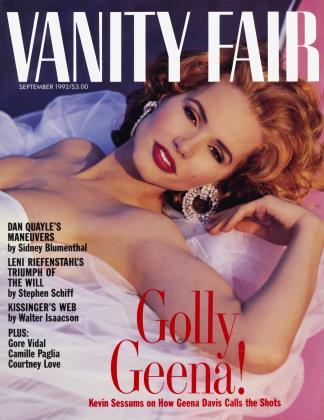Sign In to Your Account
Subscribers have complete access to the archive.
Sign In Not a Subscriber?Join NowRED DAWN
Wine
As oenophiles everywhere revel in reports that red wine is good for you, a timely guide to the best U.S. Cabernets
JOEL L. FLEISHMAN
Àvotre sante—literally!
Red wine, with its mysterious power to counteract bad cholesterol recently reported in scientific studies and ballyhooed in the press, is now enjoying a rousing renaissance in popularity. In the three months following Morley Safer's 60 Minutes segment entitled "The French Paradox" last November, sales of American reds skyrocketed—Merlot up 83 percent; Cabernet Sauvignon, 43 percent; Pinot Noir and Zinfandel, 39 percent.
In the spirit of health, and the health of spirits, this column begins a threepart series of tastings to divine the best of the current American reds. We start with Cabernet Sauvignon, which is still the best-known and best-selling red wine, though its sales have lagged in recent years as its prices have swelled. Of the ninety-six Cabernets in our tasting, twenty-two sell for $30 or more, ten are $40 or more, and the median price is $22. As recently as four years ago, only three wines in our tasting cost more than $30, and the median price was $14.
For true believers, however, a raised price is still a low hurdle when pursuing the sensuous pleasure of a serious Cabernet Sauvignon. What is meant by this term, which oenophiles apply with knitted eyebrows and a smack of the lips? In a medium-level bottle of Cabernet you'll find a wide variation in the sweetness, body, and ripeness of the potpourri of fruit flavors (blackberries, blueberries, plums, prunes, black or red cherries, raisins, raspberries). There are often unpleasant suggestions of jamminess, pruniness, raisiny overripeness, or outof-balance vegetal or herbal essences.
Serious Cabernets, on the other hand, taste of voluptuous, fresh dark plums and blackberries, all precisely at the point of just beginning to turn ripe— dry, with only the slightest breath of sweetness. Sometimes the fruit is perfumed with violets, which join the blackberries and plums to create a cassis or black-currant potion. Woven into the core of fruit are flavors that dry, deepen, and complexify the taste—usually anise, cedar, and eucalyptus-like mintiness. The texture should almost seem chewy, with the contrary tugs of bitter and sweet chocolate and the character and intensity of perfectly roasted coffee. The sum of all these essences is a powerful yet restrained, velvety wine, luxuriant but not effusive, focused, firm, dense in flavor, and hefty in weight, all its components in aristocratic, sculptured balance.
It takes a special climate and precise grape-farming and winemaking skills to produce such fine wines. Too much sun or a late harvest will result in baked, overripe flavors, which is why Bordeaux has an easier time in making serious Cabernet-based wines than California. But this year's tasting underscores the fact that many California vintners have now mastered the sun by fine-tuning their growing techniques, by picking the grapes
earlier, and by fermenting them more precisely. The result is a bumper crop of serious Cabernets as well as many interesting and satisfying lesser cousins.
The wines in our blind tasting were tasted three times: on opening and at six and eighteen hours afterward. Here are the winners, with asterisks marking my favorites (all are from California's Napa Valley unless otherwise noted):
*1987 Heitz Cellars Martha's Vineyard ($65); 1988 Sassicaia, Italy ($60);
1987 Clos du Val Reserve ($45); 1987 Beringer Private Reserve ($45); *1988 Sterling Vineyards Sterling Reserve ($40); 1988 Robert Mondavi Reserve ($40); *1988 Spottswoode ($36); *1988 Far Niente ($36); *1987 Chateau Montelena ($30); 1989 Woodward Canyon, Washington ($27); 1987 Raymond Private Reserve ($25.50); *1988 Joseph Phelps Backus Vineyard ($25); *1988 St. Clement ($20); *1989 Livingston Stanley's Selection ($20); 1988 Kenwood Jack London, Sonoma ($20); *1989 Duckhom ($20); *1988 Caymus ($20); * 1987 Clos du Bois Marlstone, Sonoma ($19); *1988 Sterling Vineyards Three Palms ($18); 1988 Sterling Vineyards Diamond Mountain Ranch ($18);
1988 Clos du Val ($18); *1989 Frog's Leap ($17); 1989 Silverado ($16); 1988 Gundlach Bundschu, Sonoma ($15); *1988 Simi, Sonoma ($14); *1988 Villa Mt. Eden Grand Reserve ($14); 1988 Fetzer Barrel Select, Sonoma/Mendocino ($11); *1988 Hess Select ($9.50).
This year's gold medal for best value goes to the 1989 Fisher Coach Insignia, a spectacular example of the serious Cabernet Sauvignon model which, at only $18, offers current and future enjoyment at a fraction of the price of a comparable wine.
We should also single out Sterling Vineyards' striking return to full stride. Its current releases all showed extremely well against strong competition, and they compare favorably to the legendary Cabernets which established the winery's blue-chip reputation twenty years ago.
 View Full Issue
View Full Issue


















Subscribers have complete access to the archive.
Sign In Not a Subscriber?Join Now